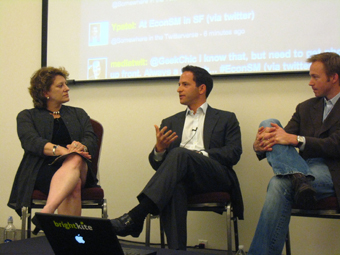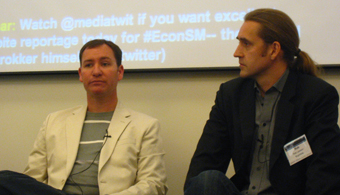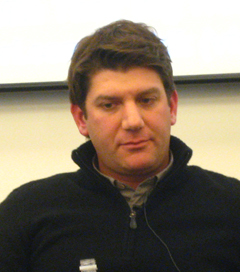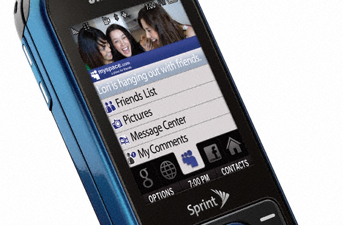SAN FRANCISCO — I am at the UCSF Mission Bay Conference Center right down the hill from where I live in Potrero Hill. Yes, it is “Bike to Work Day” today in San Francisco, but I couldn’t bike down in nice clothes. So I split the difference and walked most of the way here. The topic is how social networking is working out on mobile phones.
One interesting touch at the gathering is a huge Twitter feed for #EconSM that is being projected on a big screen on-stage behind the panelists. So the backchat, hosted by Brightkite, is literally right behind the speakers. When I crack a joke via Twitter, it goes up on-screen and I can then hear audience members cackling. Nice. (You can view it live here.)
First up is an interview on stage by Staci Kramer, PaidContent with Zander Lurie, CFO of CBS Interactive and Eric Johnson, COO, Wolfgang’s Vault.
Johnson: We just bought the archives for the Newport Jazz and Folk Festivals. It’s adding to all the archives we have from rock shows and music.
Lurie: Our paid app on iPhone for March Madness was the most popular for a few weeks. You need to have proprietary and exclusive to sell content on mobiles. March Madness was a glimpse into the ability to see HD quality video, a real-time, very social activity that took people away from work probably.

Johnson: We decided to launch our iPhone app for free at first. I was watching the Master’s during a Giants game, mobile is amazing. So we want to start by building our audience and then bring people to our website.
Q: What about CBS Radio? CBS has become powerful with Internet radio now.
Lurie: We work with colleagues in CBS Radio, we are the second largest radio business, so we have one group that includes Last.fm, the radio stations and will launch more aggressive ad campaigns and include interactive inventory. It was more difficult working across many divisions before.
I never realized how much proprietary content radio stations generate, with live studio performances and such. Or when Joe Torre did an interview after the Yankees debacle. We can put that up on our websites. We’re also working with iTunes on the pay model. There are different mediums like Twitter we can use.
Kramer: What about Amazon taking 70% of take from content partners, and Apple only takes 30%. So how do you make money with this?
Lurie: Either you are a commercial provider or a non-profit. Most of our focus and resources are toward a premium content experience on the web. We have that at CNET, GameSpot and we can get distributors to take our content with an appropriate revenue share. It depends on your leverage.
Here’s video of Lurie talking about the CBS buyout of CNET:
Q: Now that ABC has joined Hulu, CBS is the only major player not involved. Will that change?
Lurie: Somewhere down the line we might serve up videos in a non-exclusive way on Hulu, but we don’t want to have our hands tied and want to be able to distribute our video to many sites online. I don’t see us taking a stake and joining Hulu because we don’t want to make an exclusive deal with our video.
Kramer: There is talk that Quincy Smith will be leaving the company. What will happen next?
Lurie: We are working on a lot of acquisitions. We are bringing in millions of dollars in mobile, but it’s not as ad-driven. We’re out of the page views model now. It’s important to build audience and that builds engagement, but you have to show an ad opportunity through paid search. We haven’t done a full acquisition since CNET and it’s probably a good time to focus on integration.
Battle for Users by Mobile Networks
The next panel is about mobile-first social networks and how they can compete with web social networks like MySpace and Facebook. The panelists are: Justin Siegel, CEO of MocoSpace, Amir Hosseinpour, CEO of Juice Wireless, Rob Lawson, CMO of Brightkite, and Shawn Conahan, CEO of Intercasting.
Q: With web social networks moving into mobile, has that affected your businesses? Will they eat your lunch?
Siegel: I don’t think so. We haven’t noticed less usage with our network since they have entered the mobile arena. In fact, we’ve seen even more usage as they have probably brought more awareness to this market.
Q: How are users using your networks?
Siegel: People expect instantaneous responses. On Facebook, you might not hear back from people for awhile, but on mobiles people expect that instant response.
Conahan: I think the term “social networking” was ill-defined from the start. There was Friendster, and people said that was social networking, and then everything after that was considered social networking. But is Twitter a social network or social communication. It doesn’t really look like Friendster.
Q: MySpace says 35% of traffic comes from mobile, and that will go up to half. Does that sound right?
Conahan: That jibes with what I said earlier.
Rob Lawson, Brightkite: I think it’s exciting that people are adopting to communications like Twitter so quickly. Our users want to have the ability for people to track where you are in the background. So you don’t have to say where you are all the time, it just tracks you automatically. People used to be concerned about privacy but I’m not sure where that’s going.
Hosseinpour: As the cost goes down for mobile devices and the cost for data goes down, things will shift. In Europe it can cost you a couple dollars at a time to download data. A lot of us thought the floodgates would have been opened earlier. But with the iPhone and all-you-can-eat plans, that might change now.
Q: Let’s do a poll. How many of you are profitable?
[Silence from panelists.]

Siegel: We all could be profitable if we wanted to put a damper on growth. We would deliver a lesser experience to less people if we were focused on being profitable. The business model will sort itself out, traditional vs. new media. I think newspapers are the ones losing out right now.
Hosseinpour: But how many web social networks are profitable now? They’re not. Social networking is this hot thing and people are trying to make it work. We encourage carriers to think about whether it’s like voice and text, and how we can layer social networking into the interface of the phone. Users can almost invisibly update their status without having to launch a separate application.
Conahan: At Mobile World Congress, for the device award, the IMQ phone integrates Facebook into the interface. This summer it will ship in June. Sprint is launching the Samsung Lucello and Sprint will have on all its feature sets Facebook and MySpace baked in at the highest level.
Q: What about Twitter?
Hosseinpour: Twitter will be around for awhile. I think they are near their peak and will stabilize. I think they will be a major brand in social media for the next 3 to 5 years.
Siegel: There is a bit of fatigue in status-only communication. It’s been rocket fuel for Facebook and Twitter, but the early adopters of these sites are getting tired of hearing the most banal updates. “I just dropped off my kids.” “I just made soup.” I wonder who cares about that?
Conahan: But sometimes news does happen and it is important. So when something happens like a tsunami, then it does matter.
*****

Weird moment when the #EconSM feed started to talk back at the panelists while they were on stage. Here’s part of that feed:
@motherjones it gives a meta level conversation and feel to the whole conversation. I love it #econsm
@contentnow #EconSM – Tweets behind panelists heckling panel off
@motherjones does tweeting about twitter while it’s discussed in real time at #EconSM make anyone else’s brain hurt?
@mediatwit Ironic or funny that the Twitter feed on stage is turning against people on stage who are criticizing Twitter?
@Marinperez #econsm weird, some people get very upset if you dont think twitter is bigger than the love child of the beatles and jesus
@SethInSF #econsm most twitter criticisms are similar to early (and present) complaints of blogs
@mediatwit Hey guys on stage! Look up! See us mock you!
Peering into Twitter’s Mobile Future
David Callaway, editor in chief of MarketWatch, is now doing an interview with Kevin Thau, mobile business development at Twitter.
Thau: We have our own idea of how we can make money in the mobile area. Mobile carriers are making money with SMS, and we don’t think we can get a small revenue share from the carriers’ data income. We’d rather focus on growing usage right now.
Q: Timing on revenue model?
Thau: There are two areas we are going to explore. One is a set of offerings for businesses that they can purchase from us. They can still use it for free as an option. The other area is definitely around search. The details and timing are to-be-determined. They both make sense. Businesses get a lot out of using Twitter.
Q: What about changing the @replies on Twitter?
Thau: We are still working that out. We had some bumps but will try to make it work for everyone.
Q: What about your retention rates? They seem much lower than Facebook and other sites.
Here’s Thau talking about how Twitter dealt with complaints about switching the way @replies work:
Thau: Our challenge is that Twitter started and then took off and we still want to do a lot of things to make it easier of that new user. You sign up and see a blank page and then ‘What do I do now?’ We need to walk people through the learning curve, we could improve that. Because there’s all these API clients, the metrics you hear revolve around the website, but some people might switch immediately to Tweetdeck or another client. There are a lot of variables. We could make the experience stickier.
Q: What about the show on MTV that will be using Twitter?
Thau: We just hired someone focused on the entertainment business. We think it’s an interesting market that Twitter could play a role in. I think TV is looking for a way to remain fresh and Twitter is the perfect tool for that. You see it on CNN and ABC has a new show with Twitter. It can be an enabler for communication.
Mobile Sense of Discovery
Now Thau and Callaway are joined on stage by more panelists: George Linardos, VP product management at Nokia; Matt Golden at Blackberry Partners Fund; Jennifer Byrne, director of digital media at Verizon; and Sean Kane, head of mobile at Bebo.
Kane: We launched Open Mobile at Bebo and it’s now with O2 UK and it’s grown way beyond expectations. We have 17 operators with more coming, and are building out messsaging. We’re getting into video as well, and it’s rated on “likes.” That will be a massive effort. We will also include games and music.
Linardos: I think you can keep the business model pretty simple, and just stick to what works rather than try too many things.
Golden: Everyone is struggling with whether to make things free to get more users or charge money for apps. The app stores have to support people on the free side. Affiliate revenue is really compelling. There’s a travel concierge application that is phenomenal that manages your whole travel plan. So do you go with a subscription model with that? It’s a big question. There’s also the “freemium” model where you start free and then add pay products.
Kane: I’m seeing a growth of an alternative business model for mobiles. What excites me is building out a simple, direct service that all users can enjoy. It’s texting, video, WAP with display ads, and engagement marketing. All these revenue sources work for us.
Mark Glaser is executive editor of MediaShift and Idea Lab. He also writes the bi-weekly OPA Intelligence Report email newsletter for the Online Publishers Association. He lives in San Francisco with his son Julian. You can follow him on Twitter @mediatwit.

